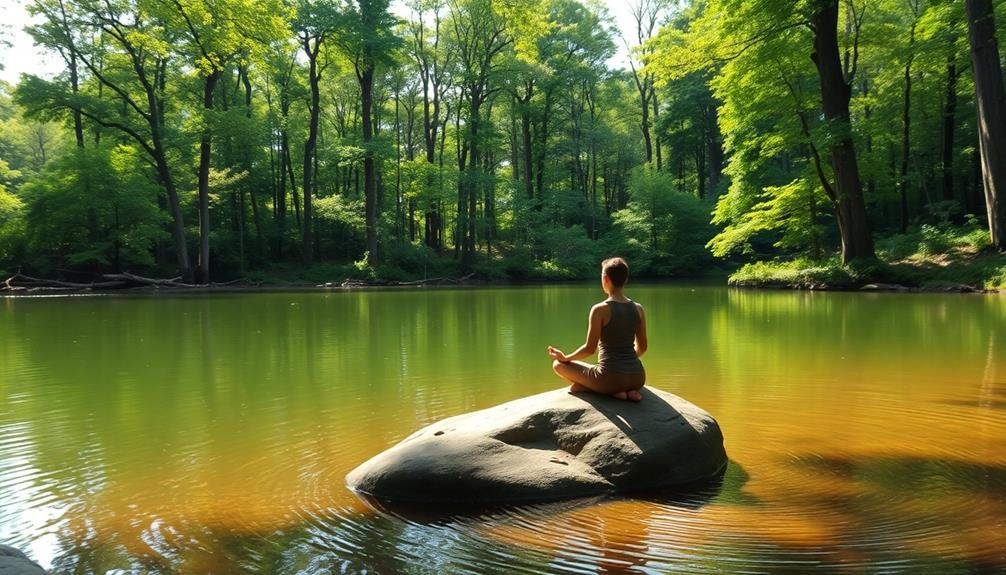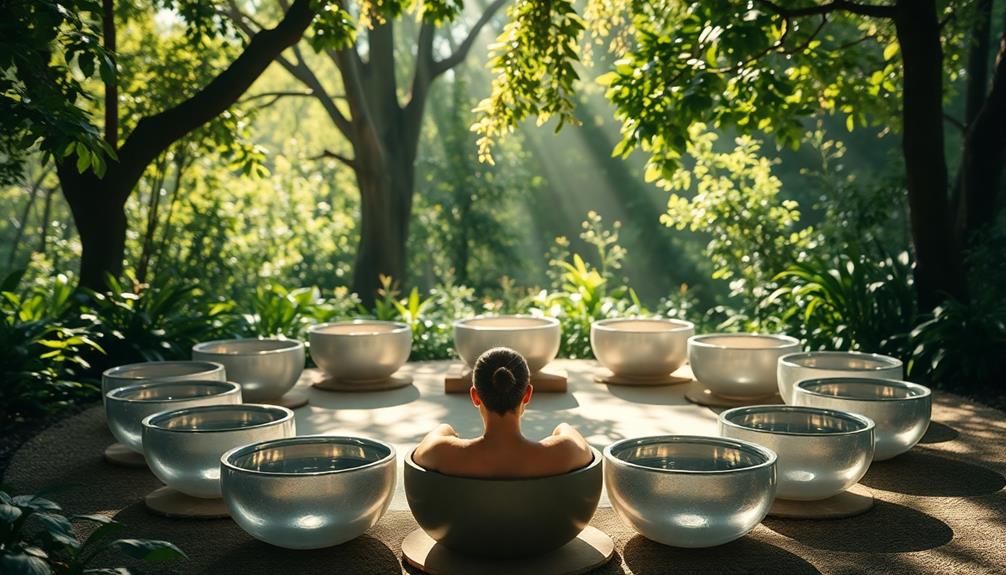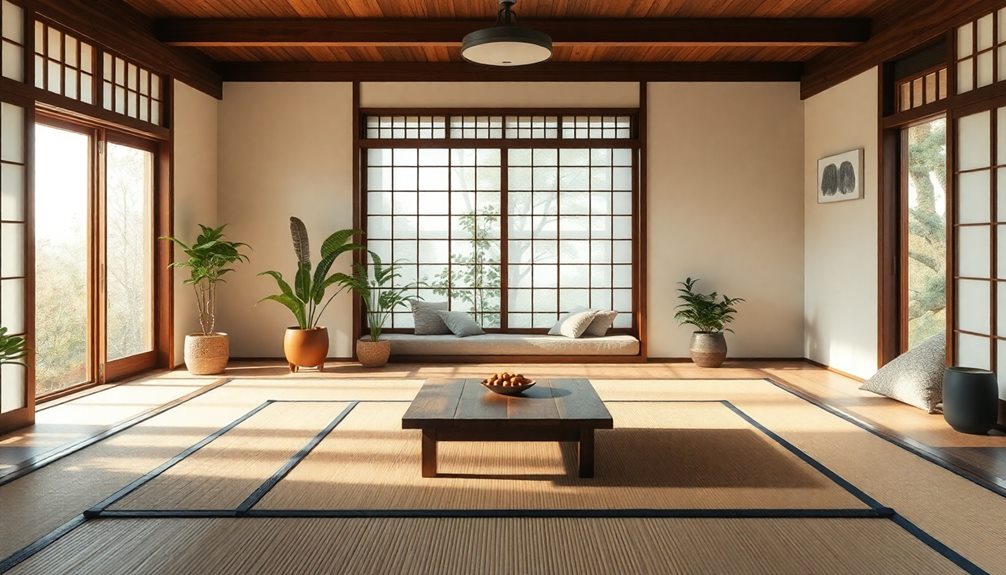To revitalize your spirit, explore wellness retreat activities designed just for you. Start your day with sunrise yoga, energizing both body and mind while setting a positive tone. Engage in guided nature walks to absorb the peace of the outdoors, allowing you to unwind and connect deeply with your surroundings. Add mindfulness and meditation to reduce stress and cultivate inner peace. Experience the calming effects of sound healing to foster emotional release and personal growth. These transformative activities build connections within yourself and with others, paving the way for lasting change. There's even more to discover about these enriching experiences.
Key Takeaways
- Engage in Sunrise Yoga Sessions to energize your body and mind while enhancing flexibility and strength.
- Experience Guided Nature Walks to unwind and connect with the tranquility of the outdoors.
- Practice Mindfulness and Meditation to reduce stress and cultivate inner peace through breath focus.
- Join Sound Healing Sessions that utilize deep tones to calm the mind and foster emotional release.
- Participate in Transformative Retreat Experiences to build community connections and support lasting lifestyle changes.
Sunrise Yoga Sessions

As the sun begins to rise, you'll find yourself energized by the gentle flow of a sunrise yoga session.
This peaceful practice not only awakens your body but also sets a positive tone for your day. You'll engage in poses that enhance flexibility and strength, while the morning light boosts your mood and liveliness.
The rhythm of your breath syncs with the natural energy around you, promoting mental clarity and focus. Each movement becomes a celebration of the new day, allowing you to release tension and embrace tranquility.
By the end of the session, you'll feel rejuvenated, ready to tackle whatever lies ahead.
Sunrise yoga isn't just exercise; it's a holistic experience that nurtures both body and mind.
Guided Nature Walks

Guided nature walks offer a revitalizing escape into the tranquility of the outdoors, allowing you to immerse yourself in the beauty of your surroundings.
These walks help you unwind and connect with nature, providing a space to release daily stressors. As you explore, you'll encounter the vibrant sights and sounds of the environment, enriching your experience.
- Feel the soft earth beneath your feet as you stroll along winding paths.
- Breathe in the fresh air filled with earthy scents and blooming flowers.
- Listen to the melodic chirps of birds and rustling leaves all around you.
- Discover local flora and fauna, deepening your appreciation for nature's wonders.
Embrace this opportunity for rejuvenation and grounding.
Mindfulness and Meditation

Mindfulness and meditation are powerful tools for cultivating inner peace and reducing stress in your daily life. By incorporating these practices, you improve your emotional resilience and enhance your focus. You can practice mindfulness anywhere, whether sitting in a quiet space or surrounded by nature. Meditation encourages deep breathing and relaxation, helping you connect with the present moment.
| Benefits | How to Practice |
|---|---|
| Reduces stress | Set aside quiet time daily |
| Enhances clarity | Focus on your breath |
| Increases resilience | Acknowledge your thoughts |
| Promotes relaxation | Visualize calm environments |
Engaging in mindfulness and meditation not only revitalizes your spirit but also equips you with strategies to navigate life's challenges more effectively.
Sound Healing Sessions

Building on the benefits of mindfulness and meditation, sound healing sessions offer a unique way to enhance your relaxation and emotional well-being.
During these sessions, you'll immerse yourself in soothing sound frequencies that resonate with your body and mind. This practice not only promotes deep relaxation but also helps clarify your emotions. You'll likely experience a heightened sense of awareness and connection to your inner self.
Here's what you can expect from sound healing sessions:
- Deep, resonating tones that calm your mind.
- Vibrational energy that fosters emotional release.
- Guided meditation to enhance your experience.
- A supportive environment for personal growth.
Engaging in sound healing can be a transformative addition to your wellness retreat journey.
Transformative Retreat Experiences

A transformative retreat experience can be a powerful catalyst for personal growth and self-discovery. You'll engage in activities that encourage connection with nature and community, while exploring workshops designed for holistic wellness. These experiences foster long-term lifestyle changes, allowing you to cultivate a healthier mindset. Participants often leave feeling rejuvenated and equipped with practical tools to integrate mindfulness into their daily routines. Simple practices learned during the retreat, such as how to transform your shower into a spa by incorporating calming scents and intentional breathing, can bring moments of serenity to everyday life. These small but impactful changes empower individuals to sustain the retreat’s benefits long after returning home.
| Activity | Benefit |
|---|---|
| Sunrise Yoga Sessions | Energizes and centers your mind |
| Guided Nature Walks | Reduces stress and enhances clarity |
| Mindfulness Meditation | Promotes inner peace and focus |
| Sound Healing Sessions | Balances emotions through sound |
| Community Workshops | Builds connections and support |
In this supportive environment, you'll find the tools needed for meaningful transformation and a renewed sense of purpose. Embrace the journey and watch yourself evolve.
Frequently Asked Questions
What Should I Bring to a Wellness Retreat?
When you're heading to a wellness retreat, pack comfortable clothes, sturdy shoes, a reusable water bottle, any personal meditation items, and a journal. Don't forget sunscreen and a hat for outdoor activities!
How Do I Choose the Right Retreat for My Needs?
To choose the right retreat for your needs, assess your goals, preferences, and budget. Research various options, read reviews, and consider the activities offered. Trust your instincts to find the perfect fit for you.
Are Wellness Retreats Suitable for Beginners?
Yes, wellness retreats are perfect for beginners. They offer supportive environments, gentle activities, and guidance from experienced instructors. You'll find opportunities to learn, grow, and connect with others while exploring your wellness journey.
What Is the Average Duration of a Wellness Retreat?
Wellness retreats typically last from a weekend to a week. You'll find various programs ranging from short getaways to longer immersive experiences, allowing you to choose what fits your schedule and goals best.
Can I Attend a Retreat Alone or Should I Bring Someone?
"Two heads are better than one," but attending a retreat alone can be just as rewarding. You'll discover self-reliance, meet new people, and embrace personal growth, creating a unique journey tailored just for you.
Conclusion
As the sun sets on your transformative journey, you'll carry the glow of newfound energy within you, like a flickering candle illuminating your path. Each sunrise yoga session, nature walk, mindfulness moment, and sound healing experience becomes a vibrant thread in the tapestry of your life. Embrace the connections you've forged with nature, community, and your true self. Step forward, renewed and invigorated, ready to face the world with a spirit that dances to the rhythm of possibility.









